锁相技术外文译文翻译
- 格式:doc
- 大小:35.00 KB
- 文档页数:9
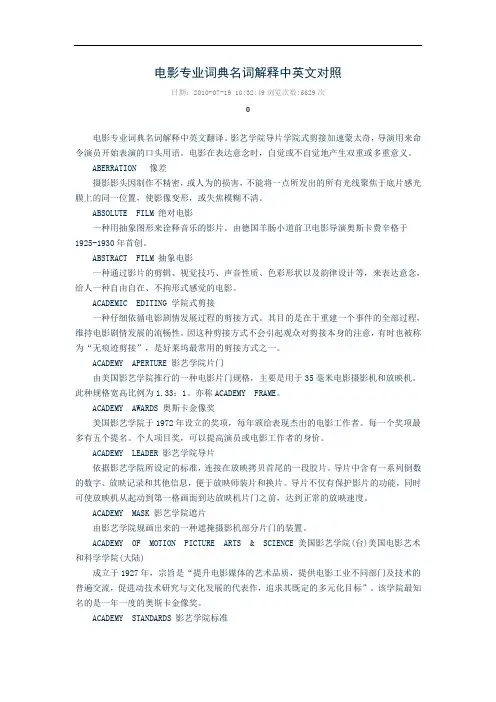
电影专业词典名词解释中英文对照日期:2010-07-19 10:32:49浏览次数:5629次电影专业词典名词解释中英文翻译。
影艺学院导片学院式剪接加速蒙太奇,导演用来命令演员开始表演的口头用语。
电影在表达意念时,自觉或不自觉地产生双重或多重意义。
ABERRATION 像差摄影影头因制作不精密,或人为的损害,不能将一点所发出的所有光线聚焦于底片感光膜上的同一位置,使影像变形,或失焦模糊不清。
ABSOLUTE FILM 绝对电影一种用抽象图形来诠释音乐的影片。
由德国羊肠小道前卫电影导演奥斯卡费辛格于1925-1930年首创。
ABSTRACT FILM 抽象电影一种通过影片的剪辑、视觉技巧、声音性质、色彩形状以及韵律设计等,来表达意念,给人一种自由自在、不拘形式感觉的电影。
ACADEMIC EDITING 学院式剪接一种仔细依循电影剧情发展过程的剪接方式。
其目的是在于重建一个事件的全部过程,维持电影剧情发展的流畅性。
因这种剪接方式不会引起观众对剪接本身的注意,有时也被称为“无痕迹剪接”,是好莱坞最常用的剪接方式之一。
ACADEMY APERTURE 影艺学院片门由美国影艺学院推行的一种电影片门规格,主要是用于35毫米电影摄影机和放映机。
此种规格宽高比例为1.33:1。
亦称ACADEMY FRAME。
ACADEMY AWARDS 奥斯卡金像奖美国影艺学院于1972年设立的奖项,每年颁给表现杰出的电影工作者。
每一个奖项最多有五个提名。
个人项目奖,可以提高演员或电影工作者的身价。
ACADEMY LEADER 影艺学院导片依据影艺学院所设定的标准,连接在放映拷贝首尾的一段胶片。
导片中含有一系列倒数的数字、放映记录和其他信息,便于放映师装片和换片。
导片不仅有保护影片的功能,同时可使放映机从起动到第一格画面到达放映机片门之前,达到正常的放映速度。
ACADEMY MASK 影艺学院遮片由影艺学院规画出来的一种遮掩摄影机部分片门的装置。

电子密码锁中英文对照外文翻译文献(文档含英文原文和中文翻译)2THE DESIGN OF MATRIX KEYBOARD AND LCD DISPLAY BASED ON MCUAbstractThe development of microelectronics technology and industrial measure requirement bring a good opportunity for development and research system,which makes it a broad prospects. The equipment has the advantages of small size, single power supply and a variety of output voltage leads it has a special module. Through the analysis of the hardware structure, we can summarizes each module needs.For example,we often go through the keys to realize the control of the electronic device. Small to watch mobile phone, to the TV computer, to a variety of complex instruments, all need to realize various operations through the buttons. This design is an important part of step for the further research,using buttons to control the display,include some modules like LCD 1602 liquid crystal display,4*4 matrix keyboard,STC89C52single-chip microcomputer and other bine with the Proteus software,the simulation results are displayed on the LCD in 1602 type of data.KEY WORDS: Single-chip; LCD 1602 liquid crystal display; 4*4 Matrix keyboard31 IntroductionWith the development of economy and the progress of science and technology, Microprocessors and peripheral chips have developed rapidly. The newest development of the integrated technology is the CPU chip and external. Like the program memory, data memory, parallel, serial, I/O timing / counter, interrupt controller and other control components are integrated in a chip—single chip. SCM has a manufacturing process CMOS, The smaller lithography process improves integration which make the chip space smaller, lower cost, lower working voltage, lower power consumption. Adopts double CPU structure, increasing the width of data bus, improve the speed and the ability of data processing, a pipeline structure, improve the processing and computing speed, in order to meet the needs of real-time control and processing. To increase the storage capacity, the internal EPROM EPPROM, secure program, to improve the driving capability of parallel port, in order to reduce the peripheral driving chip, increase the logic function and control the external I/O port flexibility. Peripheral in serial mode based expansion; peripheral circuit internal installation is an obvious trend to connect the internet. Reliability and application level is getting higher and higher. Some high-end microcontroller and launched in recent years also contains many special function unit, Such as A/D4converter, modem, communication controller, PLL, DMA, floating point unit etc.So,as we add some external expansion of the circuit and channel interface it can constitute a variety of computer applications, such as industrial control systems, data acquisition system, automatic test system, intelligent instrument, intelligent interface, function module etc. With MCU development and complete structure,SCM has become a powerful tool and will have a higher level and broader development.2 Design of the whole structure of systemThis design is based on single-chip, include matrix keyboard and LCD display module. Single-chip is the first model to select the appropriate target, function, reliability, cost, accuracy and speed control system. According to the actual situation of the topic selection, configuration management model different mainly from the following two aspects: First, supply chain management has strong anti-interference ability; second, SCM has a higher price. For information input module, keyboard selection can use economic benefits and meet the requirements of the 4*4 key matrix keyboard can realize multi function key requirements. As for the output module, using LCD 1602 liquid crystal display module, liquid crystal to achieve key information processing functions after the show. The circuit of the system is required by AT89C51 chip, clock circuit, reset circuit, driving circuit, scanning line5driving circuit and LCD1602 LCD screen. 4*4 matrix keyboard accessof P1.0 —P1.7,LCD 1602 screen to access P0.0—P0.7.3 System hardware circuit design3.1 Liquid crystal moduleThe principle of liquid crystal display is the use of physical properties of liquid crystal, The display control area voltage, power is displayed, it can display graphics. Liquid crystal display with thin thickness, suitable for large scale integrated circuit directly driven, easy to realize full color display characteristics, has been widely used in many fields of portable computer, digital camera, PDA mobile communication tools etc.1602 liquid crystal is also called the 1602 character LCD, which is a special used to display letters, numbers, symbols of the LCD module. It is composed of a plurality of 5X7 or 5X11 dot matrix character components, each dot matrix character who can display a character, there is a distance between the interval of each, there are intervals between each line, played the character spacing and row spacing, and because of this it is not well display graphics (with custom CGRAM, show the effect is not good). 1602 LCD refers to the display of the content for the 16X2, which can display two lines, 16 characters per line (LCD moduledisplay characters and numbers).63.2 Matrix keyboard module1. Key characteristicsThe keyboard is composed of a number of separate keys, press and release key is through the closed mechanical contact and off to achieve, because of the elastic action of mechanical contact, in the closing and the opening of the moment has a dither. Jitter must be eliminated, include software and hardware elimination.2.Scanning principleFirst determine whether a key is closed, and then one by one scan to further determine which button closure;(1) D0 ~ D3 output 0, level detection line D4 to D7. If the D4 - level D7 all high, said no key was pressed. If the D4 - level D7 is not all high, said the key was pressed.(2) If no key closure, return the scanning. If there is a button closure, in column by column scanning, closed key key number to find out. The D0=0, D1 ~ D3=1, D4 ~ D7 level, if D4=0, said the K1 key is pressed; similarly, if the D5 ~ D7=0, K5 respectively, K9, K13 key is down; if the D4 ~ D7=1, said that without a key is pressed. Then the D1=0, D0, D2, D3 was 1, the scanning of the second columns, which were carried on, until the closure of the key found.4 Software design7The software design mainly consists of keyboard scanning procedures, write instruction code program of LCD module, LCD module display data initialization code written subroutine, liquid crystal display module, liquid crystal display a character subroutine, time delay subroutine and so on. Programming for each module, software programming ended, Keil software was used for debugging, when the various parts of the program debugging is correct, according to the source sequence of calls, the parts together, compile, compile successfully downloaded to the mcu. The result is when the user presses a key, LCD display of the button is pressed after the realization of functional parameters corresponding to the. When the system power supply, P1 port scan cycle and the key button debounce, after completion of input through the SCM processing, output in the P0 port, through the liquid crystal display program content, complete system function.5 ConclusionWith the continuous development of high and new technology, the miniaturization and the miniaturization of electronic products has been achieved. And all kinds of new technology, as a single field of the new method, the development trend of new products and symbol -- intelligent significantly is one of the trends in development. The module design display microcontroller matrix keyboard and LCD, make us understand8to this technology innovation, through in-depth study on this technology, we can master the use in other areas, such as the design of electronic password lock, adjustment and control of indoor temperature and humidity, field access control system design etc.. Technological progress and economic development are the main themes of the present era, the improvement of people's living standard is bound to the requirements of electronic products increase, the design of any a small system is for a foundation, design of system innovation, the hardware, software integration, method and technology of virtual display and soft measurement artificial intelligence, I firmly believe that our life will be more colourful.9基于单片机的矩阵键盘与液晶显示的设计摘要微电子技术的发展和工业测量的需求,给系统的开发及深入研究带来了良好的契机,发展前景广阔。
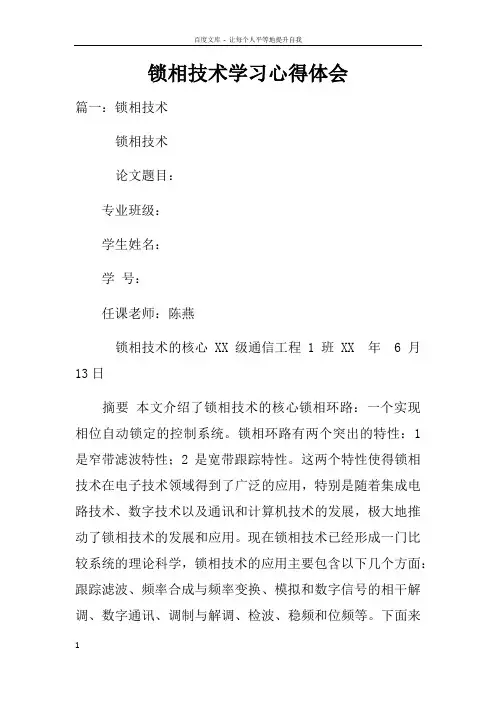
锁相技术学习心得体会篇一:锁相技术锁相技术论文题目:专业班级:学生姓名:学号:任课老师:陈燕锁相技术的核心 XX级通信工程1班 XX 年 6 月13日摘要本文介绍了锁相技术的核心锁相环路:一个实现相位自动锁定的控制系统。
锁相环路有两个突出的特性:1是窄带滤波特性;2是宽带跟踪特性。
这两个特性使得锁相技术在电子技术领域得到了广泛的应用,特别是随着集成电路技术、数字技术以及通讯和计算机技术的发展,极大地推动了锁相技术的发展和应用。
现在锁相技术已经形成一门比较系统的理论科学,锁相技术的应用主要包含以下几个方面:跟踪滤波、频率合成与频率变换、模拟和数字信号的相干解调、数字通讯、调制与解调、检波、稳频和位频等。
下面来主要介绍一下锁相技术的核心,掌握核心就能运用得当。
关键字:核心,锁相环路,运用锁相环路的工作原理:锁相环路是一种反馈电路,锁相环的英文全称是Phase-Locked Loop,简称PLL。
其作用是使得电路上的时钟和某一外部时钟的相位同步。
因锁相环可以实现输出信号频率对输入信号频率的自动跟踪,所以锁相环通常用于闭环跟踪电路。
锁相环在工作的过程中,当输出信号的频率与输入信号的频率相等时,输出电压与输入电压保持固定的相位差值,即输出电压与输入电压的相位被锁住,这就是锁相环名称的由来。
在数据采集系统中,锁相环是一种非常有用的同步技术,因为通过锁相环,可以使得不同的数据采集板卡共享同一个采样时钟。
因此,所有板卡上各自的本地 80MHz和20MHz 时基的相位都是同步的,从而采样时钟也是同步的。
因为每块板卡的采样时钟都是同步的,所以都能严格地在同一时刻进行数据采集。
锁相环路是一个相位反馈自动控制系统。
它由以下三个基本部件组成:鉴相器(PD)、环路滤波器(LPF)和压控振荡器(VCO)。
锁相环的工作原理:1. 压控振荡器的输出经过采集并分频;2. 和基准信号同时输入鉴相器;3. 鉴相器通过比较上述两个信号的频率差,然后输出一个直流脉冲电压;4. 控制VCO,使它的频率改变;5. 这样经过一个很短的时间,VCO 的输出就会稳定于某一期望值。
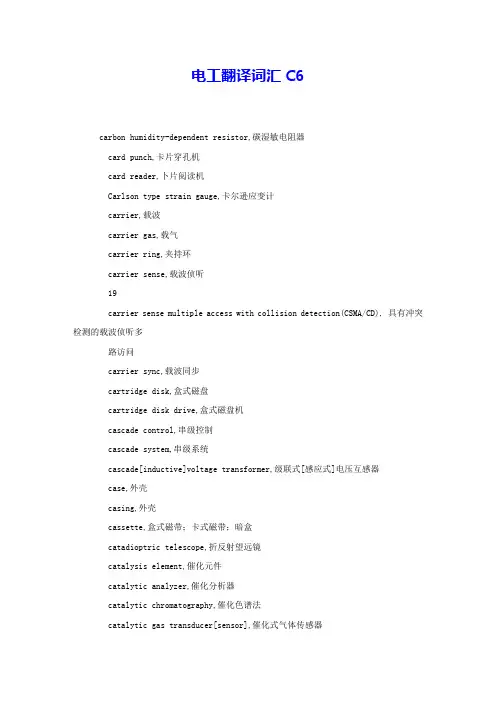
电工翻译词汇C6carbon humidity-dependent resistor,碳湿敏电阻器card punch,卡片穿孔机card reader,卜片阅读机Carlson type strain gauge,卡尔逊应变计carrier,载波carrier gas,载气carrier ring,夹持环carrier sense,载波侦听19carrier sense multiple access with collision detection(CSMA/CD), 具有冲突检测的载波侦听多路访问carrier sync,载波同步cartridge disk,盒式磁盘cartridge disk drive,盒式磁盘机cascade control,串级控制cascade system,串级系统cascade[inductive]voltage transformer,级联式[感应式]电压互感器case,外壳casing,外壳cassette,盒式磁带;卡式磁带;暗盒catadioptric telescope,折反射望远镜catalysis element,催化元件catalytic analyzer,催化分析器catalytic chromatography,催化色谱法catalytic gas transducer[sensor],催化式气体传感器cathode,阴极cathode of electron gun,电子枪阴极cathode ray null indicator,阴极射线指零仪cavitation,空化cavitation corrosion,气蚀cavitation noise,空化噪声ceilometer,云幂仪cell,电池;传感器cell constant,电池常数cell potential transducer[sensor],细胞电位传感器Celsius,摄氏度Celsius temperature,摄氏温度Celsius temperature scale,摄氏温标center of strike,打击中心central conductor method,中心导体法;电流贯通法central principal inertia axis,中心主惯性轴central processing unit(CPU),中央处理单元central processor,中央处理器centrality,集中性centralized control,集中控制centralized intelligence,集中智能centralized management system,集中管理系统centralized network,集中式网络centralized process control computer,集中型过程控制计算机centrifugal balancing machine,离心力式平衡机centrifugal tachometer,离心式转速表ceramic microphone,陶瓷传声器ceraunograph,雷电计20ceraunometer,雷电仪certificate of conformity,合格证书certificate of control,控制证书certification,认证certification of conformity of an instrument for explosive atmosphere,防爆合格证certification system,认证体系certified standard material,有证标准物质chained list,链接表change of temperature test,温度变化试验channel,信道;通道character,字符character code,字符码character recognition,字符识别character set,字符集;字符组character-at-time printer,一次一字符打印机[印刷机];串行打印机characteristic curve,特性曲线characteristic "fast","快"特性characteristic "impulse","脉冲"响应特性characteristic"slow","慢"特性characteristic locus,特征轨迹characteristic impedance,特性阻抗characteristic X-ray,特征X 射线charge amplifier,电荷放大器charge neutralization,电荷中和charge sensitivity,电荷灵敏度chart,记录纸chart driving mechanism,传纸机构chart lines,记录纸分度线chart scale length,记录纸标度尺长度closed loop transfer function,闭环传递函数closed loop zero,闭环零点closed position,关闭位置closed system,封闭系统closing valve time,关阀时间closure member,截流件cloud amount,云量cloud balancer,测支平衡器cloud base,云底cloud chamber,云室;云零室cloud detection radar,测云雷达cloud direction,云向cloud height indicator,云高指示器cloud height meter,云幂仪cloud searchlight,云幂灯。
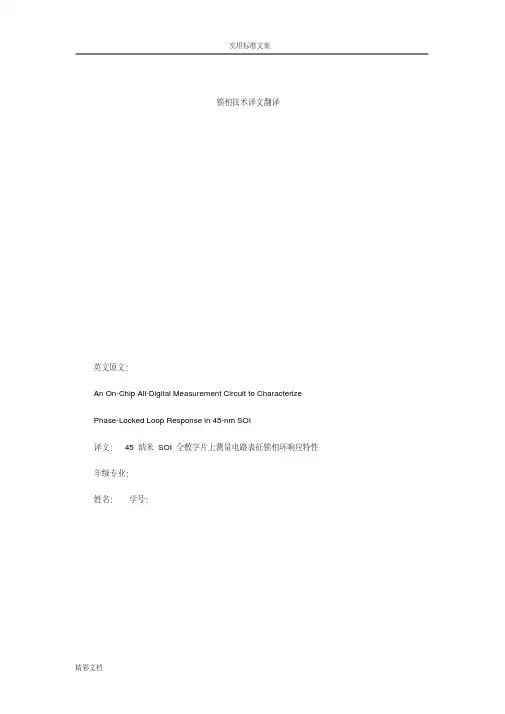
锁相技术译文翻译英文原文:An On-Chip All-Digital Measurement Circuit to Characterize Phase-Locked Loop Response in 45-nm SOI译文:45纳米SOI全数字片上测量电路表征锁相环响应特性年级专业:姓名:学号:2013 年 6 月 2 日英文中文An On-Chip All-Digital Measurement Circuit to Characterize Phase-Locked Loop Response in 45-nm SOIAbstract—An all-digital measurement Circuit , built in 45-nm SOI-CMOS enabl es on-chip characterization of phase-loc ked loop (PLL) response to a self-induce d phase step.This technique allows estimationof PLL closed-loop bandwidth and jitterpeaking. The circuit canbe used to plot step-response vs.time, measure static phase error,and observe phase-lock status. INTRODUCTIONMany applications such as PCI Express ? require a PLL to produce alow-jitter cl ock at a given frequency while meeting stringent bandwidth and jitter peaking r 45纳米SOI全数字片上测量电路表征锁相环响应特性摘要---建立在45纳米的SOI-CMOS上一个全数字测量电路,它能够表征PLL对自诱导相步进的响应这项技术允许对PLL闭环带宽和抖动峰值的估计。
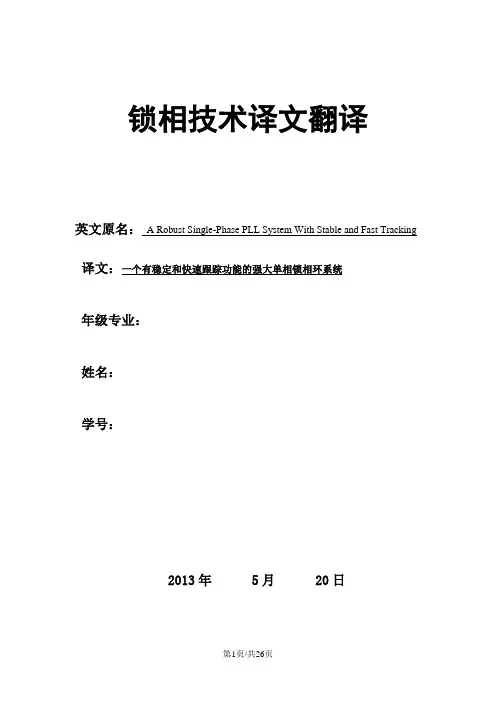
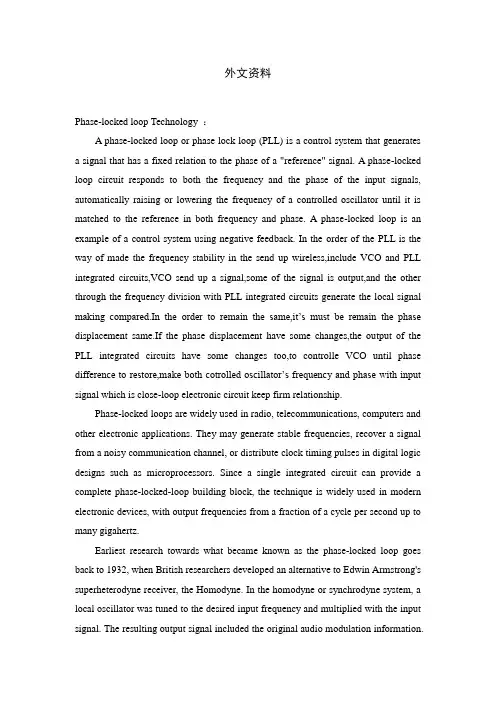
外文资料Phase-locked loop Technology :A phase-locked loop or phase lock loop (PLL) is a control system that generates a signal that has a fixed relation to the phase of a "reference" signal. A phase-locked loop circuit responds to both the frequency and the phase of the input signals, automatically raising or lowering the frequency of a controlled oscillator until it is matched to the reference in both frequency and phase. A phase-locked loop is an example of a control system using negative feedback. In the order of the PLL is the way of made the frequency stability in the send up wireless,include VCO and PLL integrated circuits,VCO send up a signal,some of the signal is output,and the other through the frequency division with PLL integrated circuits generate the local signal making compared.In the order to remain the same,it’s must be remain the phase displacement same.If the phase displacement have some changes,the output of the PLL integrated circuits have some changes too,to controlle VCO until phase diffe rence to restore,make both cotrolled oscillator’s frequency and phase with input signal which is close-loop electronic circuit keep firm relationship.Phase-locked loops are widely used in radio, telecommunications, computers and other electronic applications. They may generate stable frequencies, recover a signal from a noisy communication channel, or distribute clock timing pulses in digital logic designs such as microprocessors. Since a single integrated circuit can provide a complete phase-locked-loop building block, the technique is widely used in modern electronic devices, with output frequencies from a fraction of a cycle per second up to many gigahertz.Earliest research towards what became known as the phase-locked loop goes back to 1932, when British researchers developed an alternative to Edwin Armstrong's superheterodyne receiver, the Homodyne. In the homodyne or synchrodyne system, a local oscillator was tuned to the desired input frequency and multiplied with the input signal. The resulting output signal included the original audio modulation information.The intent was to develop an alternative receiver circuit that required fewer tuned circuits than the superheterodyne receiver. Since the local oscillator would rapidly drift in frequency, an automatic correction signal was applied to the oscillator, maintaining it in the same phase and frequency as the desired signal. The technique was described in 1932, in a paper by H.de Bellescise, in the French journal Onde Electrique.In analog television receivers since at least the late 1930s, phase-locked-loop horizontal and vertical sweep circuits are locked to synchronization pulses in the broadcast signal. When Signetics introduced a line of monolithic integrated circuits that were complete phase-locked loop systems on a chip in 1969, applications for the technique multiplied. A few years later RCA introduced the "CD4046" CMOS Micropower Phase-Locked Loop, which became a popular integrated circuit. Applications:Phase-locked loops are widely used for synchronization purposes; in space communications for coherent carrier tracking and threshold extension, bit synchronization, and symbol synchronization. Phase-locked loops can also be used to demodulate frequency-modulated signals. In radio transmitters, a PLL is used to synthesize new frequencies which are a multiple of a reference frequency, with the same stability as the reference frequency.Clock recovery :Some data streams, especially high-speed serial data streams (such as the raw stream of data from the magnetic head of a disk drive), are sent without an accompanying clock. The receiver generates a clock from an approximate frequency reference, and then phase-aligns to the transitions in the data stream with a PLL. This process is referred to as clock recovery. In order for this scheme to work, the data stream must have a transition frequently enough to correct any drift in the PLL's oscillator. Typically, some sort of redundant encoding is used; 8B10B is very common.Deskewing :If a clock is sent in parallel with data, that clock can be used to sample the data.Because the clock must be received and amplified before it can drive the flip-flops which sample the data, there will be a finite, and process-, temperature-, and voltage-dependent delay between the detected clock edge and the received data window. This delay limits the frequency at which data can be sent. One way of eliminating this delay is to include a deskew PLL on the receive side, so that the clock at each data flip-flop is phase-matched to the received clock. In that type of application, a special form of a PLL called a Delay-Locked Loop (DLL) is frequently used.Clock generation:Many electronic systems include processors of various sorts that operate at hundreds of megahertz. Typically, the clocks supplied to these processors come from clock generator PLLs, which multiply a lower-frequency reference clock (usually 50 or 100 MHz) up to the operating frequency of the processor. The multiplication factor can be quite large in cases where the operating frequency is multiple gigahertz and the reference crystal is just tens or hundreds of megahertz.Spread spectrum:All electronic systems emit some unwanted radio frequency energy. Various regulatory agencies (such as the FCC in the United States) put limits on the emitted energy and any interference caused by it. The emitted noise generally appears at sharp spectral peaks (usually at the operating frequency of the device, and a few harmonics).A system designer can use a spread-spectrum PLL to reduce interference with high-Q receivers by spreading the energy over a larger portion of the spectrum. For example, by changing the operating frequency up and down by a small amount (about 1%), a device running at hundreds of megahertz can spread its interference evenly over a few megahertz of spectrum, which drastically reduces the amount of noise seen by FM receivers which have a bandwidth of tens of kilohertz.中文翻译锁相环技术:锁相环或锁相回路(PLL)是一个信号控制系统,即用来锁定一系列的“参考”信号。
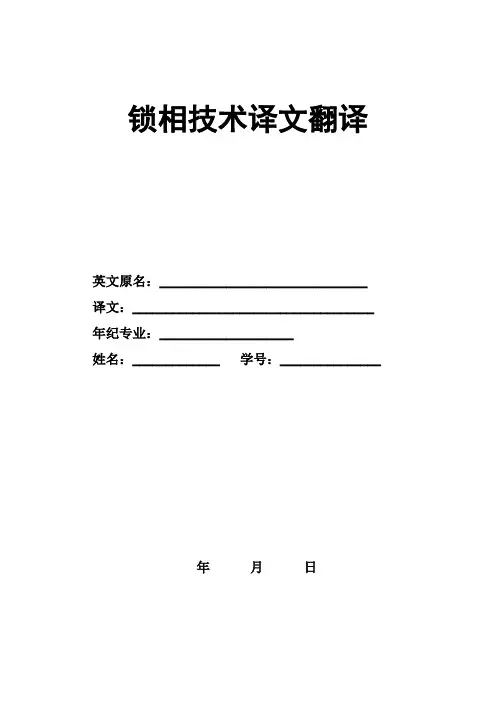
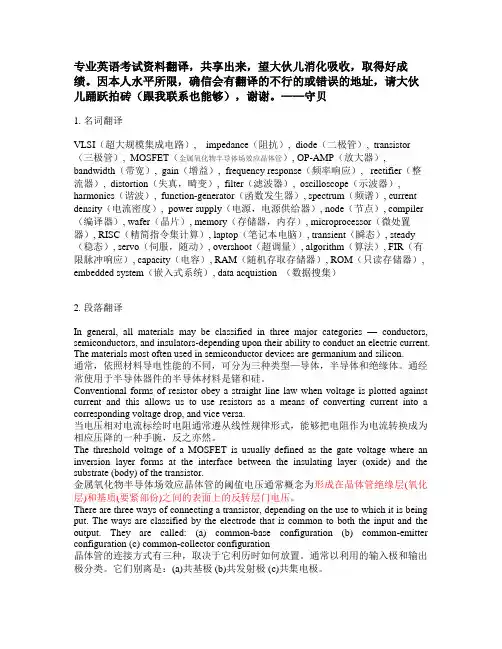
专业英语考试资料翻译,共享出来,望大伙儿消化吸收,取得好成绩。
因本人水平所限,确信会有翻译的不行的或错误的地址,请大伙儿踊跃拍砖(跟我联系也能够),谢谢。
——守贝1. 名词翻译VLSI(超大规模集成电路), impedance(阻抗), diode(二极管), transistor(三极管), MOSFET(金属氧化物半导体场效应晶体管), OP-AMP(放大器), bandwidth(带宽), gain(增益), frequency response(频率响应), rectifier(整流器), distortion(失真,畸变), filter(滤波器), oscilloscope(示波器), harmonics(谐波), function-generator(函数发生器), spectrum(频谱), current density(电流密度), power supply(电源,电源供给器), node(节点), compiler (编译器), wafer(晶片), memory(存储器,内存), microprocessor(微处置器), RISC(精简指令集计算), laptop(笔记本电脑), transient(瞬态), steady (稳态), servo(伺服,随动), overshoot(超调量), algorithm(算法), FIR(有限脉冲响应), capacity(电容), RAM(随机存取存储器), ROM(只读存储器), embedded system(嵌入式系统), data acquistion (数据搜集)2. 段落翻译In general, all materials may be classified in three major categories —conductors, semiconductors, and insulators-depending upon their ability to conduct an electric current. The materials most often used in semiconductor devices are germanium and silicon.通常,依照材料导电性能的不同,可分为三种类型—导体,半导体和绝缘体。
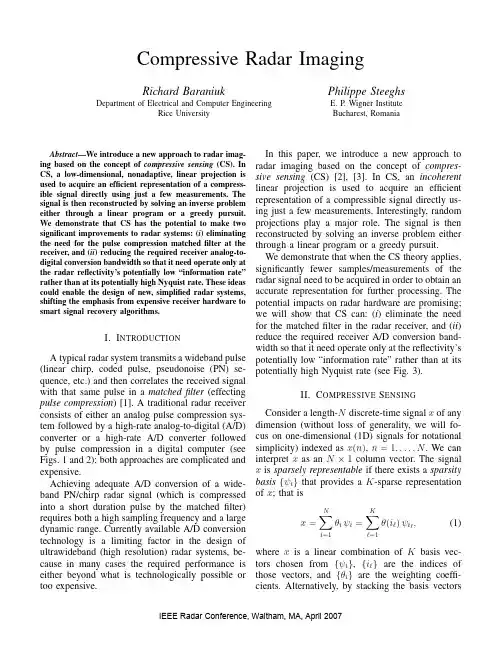
Compressive Radar ImagingRichard Baraniuk Department of Electrical and Computer EngineeringRice University Philippe Steeghs E.P.Wigner Institute Bucharest,RomaniaAbstract—We introduce a new approach to radar imag-ing based on the concept of compressive sensing(CS).In CS,a low-dimensional,nonadaptive,linear projection is used to acquire an efficient representation of a compress-ible signal directly using just a few measurements.The signal is then reconstructed by solving an inverse problem either through a linear program or a greedy pursuit. We demonstrate that CS has the potential to make two significant improvements to radar systems:(i)eliminating the need for the pulse compression matchedfilter at the receiver,and(ii)reducing the required receiver analog-to-digital conversion bandwidth so that it need operate only at the radar reflectivity’s potentially low“information rate”rather than at its potentially high Nyquist rate.These ideas could enable the design of new,simplified radar systems, shifting the emphasis from expensive receiver hardware to smart signal recovery algorithms.I.I NTRODUCTIONA typical radar system transmits a wideband pulse (linear chirp,coded pulse,pseudonoise(PN)se-quence,etc.)and then correlates the received signal with that same pulse in a matchedfilter(effecting pulse compression)[1].A traditional radar receiver consists of either an analog pulse compression sys-tem followed by a high-rate analog-to-digital(A/D) converter or a high-rate A/D converter followed by pulse compression in a digital computer(see Figs.1and2);both approaches are complicated and expensive.Achieving adequate A/D conversion of a wide-band PN/chirp radar signal(which is compressed into a short duration pulse by the matchedfilter) requires both a high sampling frequency and a large dynamic range.Currently available A/D conversion technology is a limiting factor in the design of ultrawideband(high resolution)radar systems,be-cause in many cases the required performance is either beyond what is technologically possible or too expensive.In this paper,we introduce a new approach to radar imaging based on the concept of compres-sive sensing(CS)[2],[3].In CS,an incoherent linear projection is used to acquire an efficient representation of a compressible signal directly us-ing just a few measurements.Interestingly,random projections play a major role.The signal is then reconstructed by solving an inverse problem either through a linear program or a greedy pursuit.We demonstrate that when the CS theory applies, significantly fewer samples/measurements of the radar signal need to be acquired in order to obtain an accurate representation for further processing.The potential impacts on radar hardware are promising; we will show that CS can:(i)eliminate the need for the matchedfilter in the radar receiver,and(ii) reduce the required receiver A/D conversion band-width so that it need operate only at the reflectivity’s potentially low“information rate”rather than at its potentially high Nyquist rate(see Fig.3).II.C OMPRESSIVE S ENSING Consider a length-N discrete-time signal x of any dimension(without loss of generality,we will fo-cus on one-dimensional(1D)signals for notational simplicity)indexed as x(n),n=1,...,N.We can interpret x as an N×1column vector.The signal x is sparsely representable if there exists a sparsity basis{ψi}that provides a K-sparse representationof x;that isx=Ni=1θiψi=K=1θ(i )ψi,(1)where x is a linear combination of K basis vec-tors chosen from{ψi},{i }are the indices of those vectors,and{θi}are the weighting coeffi-cients.Alternatively,by stacking the basis vectorsIEEE Radar Conference, Waltham, MA, April 2007pulsegenerator−→s T(t)to transmit antenna Fig.1.Prototypical radar transmitter.(a)s R(t)from receive antenna−→analogmatchedfilter−→high-rateA/D−→processing(b)s R(t)from receive antenna−→high-rateA/D −→digitalmatchedfilter−→processingFig.2.Prototypical digital radar receivers for the transmitter in Fig.1perform matchedfiltering either in the(a)analog or(b)digital domain.s R(t)from receive antenna−→low-rateA/D−→y−→processingpressive radar receiver for the transmitter in Fig.1performs neither matchedfiltering nor high-rate analog-to-digital conversion.as columns into the N×N sparsity basis matrix Ψ=[ψ1|...|ψN],we can write in matrix notationx=Ψθ,(2) whereθis an N×1column vector with K nonzero elements.Various expansions,including wavelets, the DCT,and Gabor frames[4],are widely used for the representation and compression of natural signals,images,and other data.Using · p to denote the p norm,we can write that θ 0=K;that is,the 0“norm” θ 0 merely counts the number of nonzero entries in the vectorθ.The signal x is compressible if the sorted magnitudes of the coefficients{|θi|}decay rapidly to zero;this is the case,for example,ifθ∈ p for p≤pressible signals are well-approximated as sparse.The standard procedure for compressing sparse signals,known as transform coding,is to(i)acquire the full N-point signal x via Nyquist-rate sampling; (ii)compute the complete set of transform coeffi-cients{θi};(iii)locate the K largest,significant co-efficients and discard the(many)small coefficients; (iv)encode the values and locations of the largest coefficients.This procedure has three inherent inefficiencies. First,for a wideband signal,we must start with a large number of Nyquist-rate samples N.Second,the encoder must compute all of the N transform coefficients{θi},even though it will discard all but K of them.Third,the encoder must encode the locations of the large coefficients since the locations change with each signal.In compressive sensing(CS),we do not measure or encode the K significantθi directly.Rather,we measure and encode M<N linear projections y(m)= x,φT m of the signal onto a second set of vectors{φm},m=1,...,M,whereφT m denotes the transpose ofφm and ·,· denotes the inner product. In matrix notation,we measurey=Φx,(3) where y is an M×1column vector and the measurement matrixΦis M×N with each row a measurement vectorφT m.Since M<N,recovery of the signal x from the measurements y is ill-posed in general.How-ever,the CS theory tells us that when the matrix ΦΨhas the Restricted Isometry Property(RIP) [2],[3],[5],then it is indeed possible to recover the K largestθi’s from a similarly sized set of M=O(K log(N/K))measurements y.The RIP is closely related to an incoherency property between ΦandΨ,where the rows ofΦdo not provide a sparse representation of the columns ofΨand vice versa.The RIP and incoherency hold for many pairsof bases,including for example,delta spikes and Fourier sinusoids,or sinusoids and wavelets.An interesting,powerful,and somewhat surpris-ing choice for the measurement matrixΦis a (pseudo)random,noise-like matrix.For example, we may select its MN entries as iid Bernoulli or Gaussian random variables(see Fig.4).It can be shown that many random measurement matrices are universal in the sense that they are incoherent with anyfixed basisΨ(spikes,sinusoids,wavelets, Gabor functions,curvelets,and so on)with high probability[2],[3],[5].1When the RIP/incoherency holds,the signal x (via its coefficentsθ)can be recovered exactly from y by solving an 1minimization problem[2],[3] θ=arg min θ1such that y=ΦΨθ.(4) This optimization problem,also known as Basis Pursuit[6],can be solved with traditional linear programming techniques.At the expense of slightly more measurements,iterative greedy algorithms such as Matching Pursuit and Orthogonal Match-ing Pursuit(OMP)[7]can recover the signal x from the measurements y.The same CS framework of incoherent measurements and optimization-based reconstruction also applies to recovering a close approximation to a compressible signal.Another choice for the measurement matrixΦthat offers good performance in many cases is a causal,quasi-Toeplitz matrix where each row is an N/M -place right-shift of the row immediately above it;that is,φm,n=p( N/M m−n)for some vector p.In this case,y=Φx can be implemented in a streaming fashion as a linear time-invariantfilter followed by decimation by D= N/M [8]y(m)=Nn=1p(Dm−n)x(n)(5)for m=1,...,M.When p is a PN sequence,we dub this approach randomfiltering(see Fig.5).1We note that it is critical that the measurement matrixΦbe known to both the encoder and decoder,so in practice it is sufficient to use a pair of pseudo-random number generators at both the encoder and decoder with a common seed known to both.III.CS-BASED R ADARIn order to illustrate our CS-based radar concept, consider a simplified1D range imaging model ofa target described by u(r)with range variable r.If we let the transmitted radar pulse s T(t)interact with the target by means of a linear convolution[1],then the received radar signal s R(t)is given bys R(t)=As T(t−τ)u(τ)dτ,(6) where we have converted the range variable r totime t using t=2rc,with c the propagation velocity of light,and where A represents attenuation due to propagation and reflection.If the transmitted signal has the property that s T(t)∗s T(−t)≈δ(t)(which is true for PN and chirp signals),then a band-limited measurement of the radar reflectivity u(t) can be obtained by pulse compression,that is,by correlating s R(t)with s T(t)in a matchedfilter (recall Fig.2)[1].A/D conversion occurs either before or after the matchedfiltering,resulting in N Nyquist-rate samples.Our CS-based radar approach is based on two key observations.First,the target reflectivity func-tions u(t)that we wish to obtain through the radar process are often sparse or compressible in some basis.For example,a set of K point targets corresponds to a sparse sum of delta functions as in u(t)=Ki=1a iδ(t−κi);smooth targets are sparse in the Fourier or wavelet domain;and range-Doppler reflectivities are often sparse in the joint time-frequency(or ambiguity)domain[1].Such target reflectivity functions u(t)are good candidates for acquisition via CS techniques.Second,time-translated and frequency-modulated versions of the PN or chirp signals transmitted as radar waveforms s T(t)form a dictionary(the extension of a basis or frame)that is incoherent with the time,frequency,and time-frequency bases that sparsify or compress the above mentioned classes of target reflectivity functions u(t)[8].This means that PN or chirp signals are good candidates for the rows of a CS acquisition matrixΦas a“random filter”(recall(5)).By combining these observations we can both eliminate the matchedfilter in the radar receiver and lower the receiver A/D converter bandwidth using CS principles.Consider a new design for a radar(a)(b)Fig.4.Theoretical compressive sensing(CS)measurement matricesΦof size N=64and M=16:(a)iid Bernoulli(±1)measurements and(b)iid Gaussian measurements.In the color map,blue corresponds to large negative,green to zero,and red to largepositive.(a)(b)Fig.5.“Randomfilter”measurement matricesΦof size N=64and M=16based on(a)PN signal and(b)chirp pare to Fig.4 and note the causal,quasi-Toeplitz,yet“rich”structure.Same color map as Fig.4.system that consists of the following components.The transmitter is the same as in a classical radar;the transmit antenna emits a PN or chirp signals T(t)(recall Fig.1).However,the receiver doesnot consist of a matchedfilter and high-rate A/Dconverter but rather only a low-rate A/D converterthat operates not at the Nyquist rate but at a rate pro-portional to the target reflectivity’s compressibility(see Fig.3).We make the connection explicit for a PN-basedCS radar with a simple sampling model.Considera target reflectivity generated from N Nyquist-ratesamples x(n)via u(t)=x( t/∆ ),n=1,...,N,on the time interval of interest0≤t<N∆.Theradar transmits a PN signal generated from a length-N random Bernoulli±1vector p(n)via s T(t)=p( t/∆ ).The received radar signal s R(t)is givenby(6);we sample it not every∆seconds but ratherevery D∆seconds,where D= N/M and M<N,to obtain the M samples,m=1,...,M,y(m)=s R(t)|t=mD∆=AN∆s T(mD∆−τ)u(τ)dτ=ANn=1p(mD−n)n∆(n−1)∆u(τ)dτ=ANn=1p(mD−n)x(n),(7)which are precisely a scaled version of(5).In words,a PN sequence radar implements a randomfilter inthe sense of[8],and hence the low-rate samplesy contain sufficient information to reconstruct thesignal x corresponding to the Nyquist-rate samplesof the reflectivity u(t)via linear programming or agreedy algorithm.Chirp pulses yield similar results.Figure6illustrates the scheme in action.A radarreflectivity profile is probed with a PN pulse se-quence,measured at one-half the Nyquist samplingrate,and subsequently recovered exactly using anOMP greedy algorithm and a sparsity frameΨcombining delta spikes and Haar wavelets.Additional gains can be expected for2D CS radarimaging.We illustrate this with a simple simulationof SAR data acquisition and imaging.Figure7(a)shows the reflectivity function that is to be recoveredfrom the SAR data.We simulated a SAR data ac-quisition using the method described in[9].Figure7(b)shows the result of a2D CS implementationwith four times undersampling,which gives an exactrecovery of the reflectivity function.The traditionalSAR image(Fig.7(c))shows artifacts of the limitedaperture of the imaging operator,which are absentin the CS image.The result is similar to what is ob-tained with the feature-enhanced imaging approachof[10].However,the CS-based approach has someadvantages,such as an almost infinite number ofsparse representations to choose from as well asmore efficient signal recovery algorithms.Fig.6.CS radar example.(a)Transmitted PN pulse s T(t),(b)low-rate measurement y,and(c)true and recovered reflectivity profiles u(t).x cross−range cross−rangeFig.7.CS synthetic aperture radar(SAR)example.(a)2D reflectivity,(b)CS SAR image,and(c)traditional SAR image.IV.D ISCUSSION AND C ONCLUSIONS Using compressive sensing(CS)ideas,we have proposed two potential improvements to a wide class of radar systems:(i)we can eliminate the matchedfilter in the radar receiver,and(ii)we can reduce the required sampling rate of the re-ceiver A/D converter so that it need only operate at the target reflectivity’s potentially low“information rate”rather than at its potentially high Nyquist rate. For example,for a scene consisting of K point targets,just M=O(K log(N/K))rather than N measurements will suffice.These ideas could enable the design of new,simplified radar systems,shifting the emphasis from expensive hardware(A/D con-version,matchedfiltering)to smart signal recovery algorithms.Reconstruction,estimation,detection, and so on are performed using a digital algorithm and can even be performed off-line.CS techniques are appropriate for monostatic, bistatic,and multiscatic(many receivers and trans-mitters)scenarios.Since the radar receiver is greatly simplified,CS provides a powerful yet inexpensive framework for multistatic sensor network radars, where the radar signals resulting from one trans-mitting antenna are received at many receiving antennas that,by virtue of our simplifications,canbe made very simply and inexpensively.Our results can also be combined with the theory of distributed compressed sensing(DCS)[11],[12]for array processing and beamforming type applications.The CS-based imaging framework introduced here also applies directly to other modalities such as sonar and synthetic aperture sonar imaging.While the CS literature has focused almost ex-clusively on problems in signal reconstruction,ap-proximation,and estimation,CS is information scal-able to a much wider range of statistical inference tasks.Detection,classification,and recognition do not require a reconstruction of the signal,but only require estimates of the relevant sufficient statistic for the problem at hand[13].A key point is that it is possible to directly extract these statistics from a small number of random measurements without ever reconstructing the signal.The two upshots are that significantly fewer measurements can be required for signal detection than for signal reconstruction and that the computational complexity of detection can be much reduced compared to reconstruction. Both of these bode well for radar applications, since if we are merely interested in detecting targets rather than reconstructing images of them,then we can use an even lower sampling rate for the CS-based receiver.Moreover,in many radar applica-tions,target detection,classification,and recognition decisions are often made based on the result of some kind of matchedfiltering or correlation with a set of rmation scalability enables us to compute close approximations to these matched filter results directly from incoherent measurements without having to perform expensive reconstruction or approximation computations[14].There are a number of challenges to be overcome before an actual CS-based radar system will become a reality.First,the target reflectivity being probed must be compressible in some basis,frame,or dictionary.Second,the signal recovery algorithms must be able to handle real-world radar acquisition scenarios with sufficient computational efficiency and robust performance for noisy data.Third,there is a subtle tradeoff to optimize between the reduc-tion in sampling rate N/M and the dynamic range of the resulting CS system[15].These are areas of active research for both our team and the broader CS community.In particular,there could be links with recent work onfinite rate of innovation sampling for ultrawideband communication systems[16].Acknowledgements:This work was supported by the grants DARPA/ONR N66001-06-1-2011and N00014-06-1-0610,NSF CCF-0431150,ONR N00014-06-1-0769and N00014-06-1-0829,AFOSR FA9550-04-1-0148,and the Texas Instruments Leadership University Program.Website: /cs.Email:richb@,philippe@.R EFERENCES[1]M.Skolnik,Radar Handbook.New York,NY,USA:McGrawHill,1970.[2] E.Cand`e s,J.Romberg,and T.Tao,“Robust uncertaintyprinciples:Exact signal reconstruction from highly incomplete frequency information,”IEEE Trans.on Information Theory, vol.52,no.2,pp.489–509,2006.[3] D.Donoho,“Compressed sensing,”IEEE Trans.on InformationTheory,vol.52,no.4,pp.5406–5425,2006.[4]S.Mallat,A Wavelet Tour of Signal Processing.San Diego:Academic Press,1999.[5]R.G.Baraniuk,M.Davenport,R. A.DeV ore,and M. B.Wakin,“A simplied proof of the restricted isometry property for random matrices(aka the Johnson-Lindenstrauss lemma meets compressed sensing),”Constructive Approximation,2007. [6]S.Chen,D.Donoho,and M.Saunders,“Atomic decompositionby basis pursuit,”SIAM J.on p.,vol.20,no.1,pp.33–61,1998.[7]J.Tropp and A.C.Gilbert,“Signal recovery from partial infor-mation via orthogonal matching pursuit,”Apr.2005.Preprint.[8]J.Tropp,M.Wakin,M.Duarte,D.Baron,and R.G.Baraniuk,“Randomfilters for compressive sampling and reconstruction,”Proc.IEEE ICASSP,2005.[9]M.Cetin,Feature-Enhanced Synthetic Aperture Radar Imaging.Ph.D.Thesis Boston University,College of Engineering,2001.[10]M.Cetin and W.C.Karl,“Feature-enhanced synthetic apertureradar image formation based on non-quadratic regularization,”IEEE Trans.Image Processing,vol.10,pp.623–631,2001. [11] D.Baron,M.B.Wakin,M.F.Duarte,S.Sarvotham,and R.G.Baraniuk,“Distributed compressed sensing,”2005.preprint.[12]M.F.Duarte,M.B.Wakin,D.Baron,and R.G.Baraniuk,“Universal distributed sensing via random projections,”in Proc.Information Processing in Sensor Networks(IPSN),2006. [13]M.Duarte,M.Davenport,M.Wakin,and R.G.Baraniuk,“Sparse signal detection from incoherent projections,”Proc.IEEE ICASSP,2005.[14]M.Davenport,M.Duarte,M.Wakin,D.Takhar,K.K.Kelly,and R.G.Baraniuk,“The smashedfilter for compressive classi-fication and target recognition,”in Proc.IS&T/SPIE Symposium on Electronic Imaging:Computational Imaging,Jan.2007. [15]ska,S.Kirolos,M.F.Duarte,T.S.Ragheb,R.G.Baraniuk,and Y.Massoud,“Theory and implementation of an analog-to-information converter using random demodulation,”in IEEE ISCAS,2007.[16]I.Maravic,J.Kusuma,and M.Vetterli,“Low-sampling rateUWB channel characterization and synchronization,”m.and Networks,vol.5,Dec.2003.。

毕业论文(设计)文献翻译本翻译源自于:RFID Handbook (Second Edition)毕业设计名称:电力系统高速数据采集系统设计外文翻译名称:射频识别技术手册(第二版)学生姓名:翁学娇院(系):电子信息学院专业班级:电气10803指导教师:唐桃波辅导教师:唐桃波时间:2012年2月至2012年6月射频识别技术手册:基于非接触式智能卡和识别的原理和使用第二版Klaus Finkenzeller版权 2003 John Wiley& Sons有限公司国际标准图书编号:0-470-84402-75.频率范围和无线电许可条例5.1 频率范围因为射频识别系统产生和辐射电磁波,他们已被列为合法的无线电系统。
其他功能的无线服务在任何情况下都不能受到射频识别操作系统的干扰和损害。
尤其重要的是要确保RFID系统不会干扰附近的广播和电视,移动无线电服务(警察、保安服务、工业),航海和航空无线电服务和移动电话。
对射频识别系统来讲,运动保健方面需要的其他无线电服务明显制约了适宜范围内的可操作频(图 5.1).出于这个原因,它通常是唯一可以使用的频率范围,已经有人预定了专供工业,科学和医学中的使用。
这些世界范围内的频率划分成国际频率范围(工业-科学-医学),它们也可以用于射频识别使用。
实际可用的射频频率f::图5.1 用于射频识别系统范围内的频率范围为135千赫一下的超长范围通过短波以及超短波到微波范围,包括最高频率24千兆赫。
在上述的135千赫的范围内,可用的ISM频段是全球首选。
80604020252500.0130000VLF0.13000LF1300MF1030HF1003VHF10000.3UHF100000.03SHF1000000.003EHF:MHZm6.78 13.56 27.125 40 66 433 868 915 2450 5800 MHZ 24GHZH, dBμA/m/10 m(< 30 MHz)BC, LW-/MW-NavigationSW (Com., BC, Mobile, Marine...)FM Radio, Mobile Radio, TVMicrowave Link, SAT-TVNon-ITUITU, not fully deployed100-135kHz 13.56MHz2.45GHz图5.2 百万应答机单元中的不同频率范围的转发器的全球市场估计分布除了ISM 频率,整个频率范围内低于135千赫(在北美、南美和日本:低于400千赫)也是可用的,因为在这个范围内,它是可能和高磁场的优势联合工作的,特别是操作时电感耦合的射频识别系统。
微细电解磨削摘要本文阐述了电解加工微细结构。
通过采用超短脉冲,被加工的零件可以被限制在非常接近一个电极的尺寸范围内。
应用这种方法可以加工不锈钢三维微结构。
采用0.1Mol/L低浓度的H2SO4电解液中可以得到好的表面质量的结构。
在电解加工中,随着加工深度提高会出现锥度,为降低锥度、本文采用了一种辅助圆盘型电极。
电解磨可加工各种三维微观结构,包括直径60微米的半球。
1.简介微细加工技术已成为生产微小零件或设备的一个重要手段。
一种微细加工技术是光刻,其已经在微机电系统(MEMS)领域得到发展。
尽管这一过程有许多优势,如可实现规模生产及高分辨率,但这种方法只限于二维硅加工。
LIGA技术使用于金属材料及高分子材料和陶瓷制造微细结构加工[1],这项技术是基于深蚀刻、光刻复制工艺,诸如电铸和微细成型。
LIGA技术也仅限于高深宽比的二维微结构的工艺制备。
对于硬质合金的三维微加工,有一些技术可以实现,如微细机械磨削,微细电火花加工、电解加工。
微细磨削以高速和低成本应用于微机械结构[2, 3]。
舒斯特等研究者在不锈钢上用微细磨刀加工出了小于50微米的微细沟槽。
在研磨过程中,微细磨具受刀具磨损和破损的威胁极易断裂。
而且, 加工结束后必须辅以去除毛刺的过程。
微细电火花是一种的非传统加工工艺,可通过电极与工件间的放电加工导电材料,而且不管材料的机械性能如何,微细电火花加工能加工出微结构和微孔[4, 5]。
电火花是一种放热过程中, 电极以及工件在加工中都会被损耗,因此三维机械结构的电火花加工,电极磨损量应预知并进行补偿[5]。
而电解加工是基于电极和工件之间的电解反应,它以其加工金属材料时无机械应力,不产生热影响区和刀具无磨损等优点,在制造业中被广泛使用。
但电解加工加工速度相对较其它微加工方法较大尚未应用于微细加工。
最近,舒斯特等研究显示通过采用超短脉冲纳秒加工精度可以控制在微米级。
采用高浓度3Mol/L HCl和6Mol/L的HF电解液不能加工不锈钢材料的微细结构[6, 7],因此需要继续研究需要找到一种具有较小腐蚀性的电解液的加工不锈钢的方法。
附件C :译文基于离散混沌映射的图像加密并行算法摘要:最近,针对图像加密提出了多种基于混沌的算法。
然而,它们都无法在并行计算环境中有效工作。
在本文中,我们提出了一个并行图像加密的框架。
基于此框架内,一个使用离散柯尔莫哥洛夫流映射的新算法被提出。
它符合所有并行图像加密算法的要求。
此外,它是安全、快速的。
这些特性使得它是一个很好的基于并行计算平台上的图像加密选择。
1. 介绍最近几年,通过计算机网络尤其是互联网传输的数字图像有了快速增长。
在大 多数情况下,传输通道不够安全以防止恶意用户的非法访问。
因此,数字图像的安全性和隐私性已成为一个重大问题。
许多图像加密方法已经被提出,其中基于混沌的方法是一种很有前途的方向[1-9]。
总的来说,混沌系统具有使其成为密码系统建设中重要组成部分的几个属性:(1)随机性:混沌系统用确定的方法产生长周期、随机的混沌序列。
(2)敏感性:初始值或系统参数的微小差异导致混沌序列的巨大变化。
(3)易用性:简单的公式可以产生复杂的混沌序列。
(4)遍历性:一个混沌状态的变量能够遍历它的相空间里的所有状态,通常这些状态都是均匀分布的。
除了上述性能,有些二维(2D )的混沌映射是图像像素置换天生的优良替代者。
Pichler 和Scharinger 提出一种在扩散操作[1,2]之前使用柯尔莫哥洛夫流映射的图像排列方式。
后来,Fridrich 将此方法扩展到更广义的方式[3]。
陈等人提出基于三维猫映射的图像加密算法[4]l 。
Lian 等人提出基于标准映射的另一种算法[5]。
其实,这些算法在相同的框架下工作:所有的像素在用密码分组链接模式(CBC)模式下的加密之前首先被用离散混沌映射置换,当前像素密文由以前的像素密文影响。
上述过程重复几轮,最后得到加密图像。
这个框架可以非常有效的实现整个图像的扩散。
但是,它是不适合在并行计算环境中运行。
这是因为当前像素的处理无法启动直到前一个像素已加密。
光刻机单词单词:光刻机1.1 词性:名词1.2 释义:一种用于制造芯片等半导体器件的高精度设备,通过曝光、显影等工艺将电路图案转移到硅片等基材上。
1.3 英文释义:A high-precision device used in the manufacturing of semiconductor devices such as chips, which transfers circuit patterns onto substrates like silicon wafers through processes like exposure and development.1.4 相关词汇:光刻胶(photoresist)、掩膜版(mask)、曝光(exposure)---2 起源与背景2.1 词源:“光刻”一词来源于光学光刻技术的原理,即利用光线对涂有光刻胶的基材进行曝光以形成图案。
随着半导体技术发展,专门用于此工艺的高精度设备被称为光刻机。
2.2 趣闻:在早期半导体制造中,光刻机的精度相对较低,但随着科技进步,如今的光刻机已经能够实现纳米级别的加工精度,其发展历程见证了半导体产业从起步到繁荣的巨大跨越。
---3 常用搭配与短语3.1 短语:- 光刻机技术:解释为与光刻机相关的各项技术工艺。
例句:The development of lithography machine technology is crucial for the semiconductor industry. 翻译:光刻机技术的发展对半导体产业至关重要。
- 先进光刻机:表示在性能、精度等方面处于领先水平的光刻机。
例句:This company has introduced an advanced lithography machine. 翻译:这家公司引进了一台先进的光刻机。
- 操作光刻机:关于如何使用光刻机的表述。
例句:The engineer is trained to operate the lithography machine. 翻译:这位工程师接受过操作光刻机的培训。
流体力学英语词汇翻译(2)流体力学英语词汇翻译(2) 动量厚度 momentum thickness 能量厚度 energy thickness焓厚度 enthalpy thickness注入 injection吸出 suction泰勒涡 taylor vortex速度亏损律 velocity defect law形状因子 shape factor测速法 anemometry粘度测定法 visco[si] metry流动显示 flow visualization油烟显示 oil smoke visualization 孔板流量计 orifice meter频率响应 frequency response油膜显示 oil film visualization 阴影法 shadow method纹影法 schlieren method烟丝法 smoke wire method丝线法 tuft method氢泡法 nydrogen bubble method相似理论 similarity theory相似律 similarity law部分相似 partial similarity定理 pi theorem, buckingham theorem 静[态]校准 static calibration动态校准 dynamic calibration风洞 wind tunnel激波管 shock tube激波管风洞 shock tube wind tunnel 水洞 water tunnel拖曳水池 towing tank旋臂水池 rotating arm basin扩散段 diffuser测压孔 pressure tap皮托管 pitot tube普雷斯顿管 preston tube斯坦顿管 stanton tube文丘里管 venturi tubeu形管 u-tube压强计 manometer微压计 micromanometer多管压强计 multiple manometer 静压管 static [pressure]tube 流速计 anemometer风速管 pitot- static tube激光多普勒测速计 laser doppler anemometer, laser doppler velocimeter热线流速计 hot-wire anemometer热膜流速计 hot- film anemometer流量计 flow meter粘度计 visco[si] meter涡量计 vorticity meter传感器 transducer, sensor压强传感器 pressure transducer热敏电阻 thermistor示踪物 tracer时间线 time line脉线 streak line尺度效应 scale effect壁效应 wall effect堵塞 blockage堵寒效应 blockage effect动态响应 dynamic response 响应频率 response frequency 底压 base pressure菲克定律 fick law巴塞特力 basset force埃克特数 eckert number格拉斯霍夫数 grashof number努塞特数 nusselt number普朗特数 prandtl number雷诺比拟 reynolds analogy施密特数 schmidt number斯坦顿数 stanton number对流 convection自由对流 natural convection, free convec-tion 强迫对流 forced convection热对流 heat convection质量传递 mass transfer传质系数 mass transfer coefficient 热量传递 heat transfer传热系数 heat transfer coefficient 对流传热 convective heat transfer 辐射传热 radiative heat transfer 动量交换 momentum transfer能量传递 energy transfer传导 conduction热传导 conductive heat transfer热交换 heat exchange临界热通量 critical heat flux 浓度 concentration扩散 diffusion扩散性 diffusivity扩散率 diffusivity扩散速度 diffusion velocity 分子扩散 molecular diffusion 沸腾 boiling蒸发 evaporation气化 gasification凝结 condensation成核 nucleation计算流体力学 putational fluid mechanics多重尺度问题 multiple scale problem伯格斯方程 burgers equation对流扩散方程 convection diffusion equation kdu方程 kdv equation修正微分方程 modified differential equation 拉克斯等价定理 lax equivalence theorem数值模拟 numerical simulation大涡模拟 large eddy simulation数值粘性 numerical viscosity非线性不稳定性 nonlinear instability希尔特稳定性分析 hirt stability analysis相容条件 consistency conditioncfl条件 courant- friedrichs- lewy condition ,cfl condition 狄里克雷边界条件 dirichlet boundary condition熵条件 entropy condition远场边界条件 far field boundary condition流入边界条件 inflow boundary condition无反射边界条件 nonreflecting boundary condition数值边界条件 numerical boundary condition流出边界条件 outflow boundary condition冯.诺伊曼条件 von neumann condition近似因子分解法 approximate factorization method 人工压缩 artificial pression人工粘性 artificial viscosity边界元法 boundary element method配置方法 collocation method能量法 energy method有限体积法 finite volume method流体网格法 fluid in cell method, flic method通量校正传输法 flux-corrected transport method通量矢量分解法 flux vector splitting method伽辽金法 galerkin method积分方法 integral method标记网格法 marker and cell method, mac method 特征线法 method of characteristics直线法 method of lines矩量法 moment method多重网格法 multi- grid method板块法 panel method质点网格法 particle in cell method, pic method 质点法 particle method预估校正法 predictor-corrector method投影法 projection method准谱法 pseudo-spectral method随机选取法 random choice method激波捕捉法 shock-capturing method激波拟合法 shock-fitting method谱方法 spectral method稀疏矩阵分解法 split coefficient matrix method 不定常法 time-dependent method时间分步法 time splitting method变分法 variational method涡方法 vortex method隐格式 implicit scheme显格式 explicit scheme交替方向隐格式 alternating direction implicit scheme, adi scheme反扩散差分格式 anti-diffusion difference scheme紧差分格式 pact difference scheme守恒差分格式 conservation difference scheme克兰克-尼科尔森格式 crank-nicolson scheme杜福特-弗兰克尔格式 dufort-frankel scheme指数格式 exponential scheme戈本诺夫格式 godunov scheme高分辨率格式 high resolution scheme拉克斯-温德罗夫格式 lax-wendroff scheme蛙跳格式 leap-frog scheme单调差分格式 monotone difference scheme保单调差分格式 monotonicity preserving difference scheme穆曼-科尔格式 murman-cole scheme半隐格式 semi-implicit scheme斜迎风格式 skew-upstream scheme全变差下降格式 total variation decreasing scheme tvd scheme 迎风格式 upstream scheme , upwind scheme计算区域 putational domain物理区域 physical domain影响域 domain of influence依赖域 domain of dependence区域分解 domain deposition维数分解 dimensional split物理解 physical solution弱解 weak solution黎曼解算子 riemann solver守恒型 conservation form弱守恒型 weak conservation form 强守恒型 strong conservation form散度型 divergence form贴体曲线坐标 body- fitted curvilinear coordi-nates [自]适应网格 [self-] adaptive mesh适应网格生成 adaptive grid generation自动网格生成 automatic grid generation数值网格生成 numerical grid generation交错网格 staggered mesh网格雷诺数 cell reynolds number数植扩散 numerical diffusion数值耗散 numerical dissipation数值色散 numerical dispersion数值通量 numerical flux放大因子 amplification factor放大矩阵 amplification matrix阻尼误差 damping error离散涡 discrete vortex熵通量 entropy flux熵函数 entropy function分步法 fractional step method广义连续统力学 generalized continuum mechanics 简单物质 simple material纯力学物质 purely mechanical material微分型物质 material of differential type积分型物质 material of integral type混合物组份 constituents of a mixture非协调理论 inpatibility theory微极理论 micropolar theory决定性原理 principle of determinism等存在原理 principle of equipresence局部作用原理 principle of objectivity客观性原理 principle of objectivity电磁连续统理论 theory of electromagic continuum 内时理论 endochronic theory非局部理论 nonlocal theory混合物理论 theory of mixtures里夫林-矣里克森张量 rivlin-ericksen tensor 声张量 acoustic tensor半向同性张量 hemitropic tensor各向同性张量 isotropic tensor应变张量 strain tensor伸缩张量 stretch tensor连续旋错 continuous dislination连续位错 continuous dislocation动量矩平衡 angular momentum balance余本构关系 plementary constitutive relations共旋导数 co-rotational derivative, jaumann derivative 非完整分量 anholonomic ponent爬升效应 climbing effect协调条件 patibility condition错综度 plexity当时构形 current configuration能量平衡 energy balance变形梯度 deformation gradient有限弹性 finite elasticity熵增 entropy production标架无差异性 frame indifference 弹性势 elastic potential熵不等式 entropy inequality极分解 polar deposition低弹性 hypoelasticity参考构形 reference configuration 响应泛函 response functional动量平衡 momentum balance奇异面 singular surface贮能函数 stored-energy function 内部约束 internal constraint物理分量 physical ponents本原元 primitive element普适变形 universal deformation速度梯度 velocity gradient测粘流动 visetric flow当地导数 local derivative岩石力学 rock mechanics原始岩体应力 virgin rock stress构造应力 tectonic stress三轴压缩试验 three-axial pression test 三轴拉伸试验 three-axial tensile test三轴试验 triaxial test岩层静态应力 lithostatic stress吕荣 lugeon地压强 geostatic pressure水力劈裂 hydraulic fracture咬合[作用] interlocking内禀抗剪强度 intrinsic shear strength 循环抗剪强度 cyclic shear strength残余抗剪强度 residual shear strength 土力学 soil mechanics孔隙比 void ratio内磨擦角 angle of internal friction 休止角 angle of repose孔隙率 porosity围压 ambient pressure渗透系数 coefficient of permeability [抗]剪切角 angle of shear resistance 渗流力 seepage force表观粘聚力 apparent cohesion粘聚力 cohesion稠度 consistency固结 consolidation主固结 primary consolidation次固结 secondary consolidation固结仪 consolidometer浮升力 uplift扩容 dilatancy有效应力 effective stress絮凝[作用] floulation主动土压力 active earth pressure 被动土压力 passive earth pressure 土动力学 soil dynamics应力解除 stress relief次时间效应 secondary time effect 贯入阻力 peration resistance沙土液化 liquefaction of sand泥流 mud flow多相流 multiphase flow马格努斯效应 magnus effect韦伯数 weber number环状流 annular flow泡状流 bubble flow层状流 stratified flow平衡流 equilibrium flow二组份流 two-ponent flow冻结流 frozen flow均质流 homogeneous flow二相流 two-phase flow气-液流 gas-liquid flow气-固流 gas-solid flow液-气流 liquid-gas flow液-固流 liquid-solid flow液体-蒸气流 liquid-vapor flow 浓相 dense phase稀相 dilute phase连续相 continuous phase离散相 dispersed phase悬浮 suspension气力输运 pneumatic transport 气泡形成 bubble formation体密度 bulk density壅塞 choking微滴 droplet挟带 entrainment流型 flow pattern流[态]化 fluidization界面 interface跃动速度 saltation velocity非牛顿流体力学 non-newtonian fluid mechanics 非牛顿流体 non-newtonian fluid幂律流体 power law fluid拟塑性流体 pseudoplastic fluid触稠流体 rheopectic fluid触变流体 thixotropic fluid粘弹性流体 viscoelastic fluid流变测量学 rheometry震凝性 rheopexy体[积]粘性 bulk viscosity魏森贝格效应 weissenberg effect流变仪 rheometer稀薄气体动力学 rarefied gas dynamics物理化学流体力学 physico-chemical hydrodynamics 空气热化学 aerothermochemistry绝对压强 absolute pressure绝对反应速率 absolute reaction rate绝对温度 absolute temperature吸收系数 absorption coefficient活化分子 activated molecule活化能 activation energy绝热压缩 adiabatic pression绝热膨胀 adiabatic expansion绝热火焰温度 adiabatic flame temperature 电弧风洞 arc tunnel原子热 atomic heat雾化 atomization自燃 auto-ignition自动氧化 auto-oxidation可用能量 available energy缓冲作用 buffer action松密度 bulk density燃烧率 burning rate燃烧速度 burning velocity 接触面 contact surface烧蚀 ablation模板,内容仅供参考。
1.Key Techniques of the X-ray Inspection Real-time Imaging Pipeline Robot This paper presentsa robotic system for weld-joint inspection of the big-caliber control ofsyncbro-follow control technique it can accomplish the technologic task of weld inspection. Therobotic system is equipped with a small focal spot and directional beam X-ray tube so the higherdefinition image of weld-seam can be obtained.Several key techniques about the robotic systemdeveloped are also explained in detail . Its construction is outlined.Key words : X-ray inspection:real-time imagingrobotIntroduction Compared with radiographic examination teohniqueRETX-ray real time imaginginspection techniqueRTIIT has many advantages such as higher efficiency lower cost betterfeasible automation and weld-defects evaluation on-line.Furthermore,up to date technologyallows the X-ray RTIIT to be used in Non-Destructive Testing NDT of pipelines,and theinspection quality of this Technique is as good as that of the RET. Therefore NDT equipments,which are used commonly in pipeline inspection and basing on the RET,need to be renovated bybasing on the X-ray RTIIT. To employ the X-ray RTITT in NDT of pipeline there must be an automation platform,andX-ray inspection real-time imaging pipeline robotIRTIPR is designed for the purpose. In factbesides the problems that have been resolved and are involved in the X-ray IRTIPRseveral keytechniques are presented in this paperin which we address the robot focusing on its intelligentcontrol such as the autonomous motion in-pipe,the synchro-follow controltechnique and thecommunication of cooperation between in-pipe and out-pipe and we also outline the constructionof the robot.1 Composing and Working Principle of the Robot The X -ray IRTIPR connints of the two parts of in-pipe and out-pipe,as illustrated in Figl1 .The out-pipe part is camposed of mage collecting and processing system ,out-pipesynchro-rotary mechanism and its driving system.The image intensifier is driven by the out-piperotary mechanism to rotate round the center of pipeline to collect weld image and transmit videosignal to image processing computer image-collecting card. The in-pipe part is composed ofin-pipe computer,power and invcrters system ,walking and driving system ,X-ray system,in-pipe synchro-rotary rncchanism and its driving system and weld 一seam autonomous seekingand locating system .TheX -ray tube in x-ray system is driven by the in-pipe rotary mechanism torotate round the center of pipeline. The main working principle of the robot is explained as follows:Under the control ofweld-seam autonomous seeking and locating system the in-pipe crawler finishes the localizationof working position at which the in-pipe crawler is in a state of waiting. When it receives thecommand signal from out-pipe which is transmitted by low frequency electromagnetic wave thein-pipe computer operates immediately the controller of X-ray system to realize its out-pipecontrol. In sequence the in-pipe and out-piperotary mechanisms are controlled by thesynchro-followcontrol technique to rotate with the same center of pipeline and finish weld-seaminspection in the manner of rotating-irradiating-ratating.2 The Control Systern of the Robot2. 1 The Synchro-follow Control Technique of In-pipe and Out-pipe Rotary Mechanism In the light of the technologic requirement of X-ray RTIIT the X-ray tube and the imageintensifier must be required to rotate synchronously with the same center.Because the X-rayIRTIPR adopts wireless working manner,i .e. there is no tether cables linking in-pipe without-pipe parts of the robot.How to realize the synchro-message communication between in-pipeand out-pipe control systems of rotary mechanism or how to realize synchro-control thenbecomes a key technique that must be solved.2.2 Weld-seam Autonomous Seeking and Locating Technique Autonomous seeking and locating mean that the robot determines automatically where is theworking positionin-pipe with the help of sensors but without any ones inter-meddling. Thiscontrol-manner is actuallyfntelligent. The precision and reliability of seeking and locating asystem have direct relation with if a robot can realize autonomous motion in-pipe. If this system isdisabled the robot will take the place of the accident ofdeathor7ose the wayin-pipe. Generally methods for detecting. the position of weld-seam are as follows:1 Utilizeencoder or cyclometer 2 Utilize the displacement caused by the protrusion-concave changing ofweld-seam surface3 Utilize if the zone of weld-seam conducts electricity 4 Utilize radioactiveisotope such as y ray source 5 Utilize vision 6 Utilize low frequency electromagnetic wave.3 Conclusion Key techniques of the X-ray IRTIPR are assurances for X-ray RTIIT to realize automation. Ifa robot adopts the working means of having no cable and the synchro-follow control technique ofin-pipe and out-pipe rotary mechanisms being not solved,it will be impossible for the X-rayRTHT to realize automation at all .The weld-seam autonomous seeking and locating technique is aconcrete embodiment ofintelligencefor the robot and is also an assurance for the robot to workwith high reliability.x身寸线实时影象探伤管道机器人的关键技术摘要这篇论文介绍了一种检查大口径管道焊接连接的机器人系统,它被发展作为X 射线实时图象检查法RTIIT的自动化平台。
1、锁具结构mechanisms of lock1.1 弹子结构Pin tumbler mechanism 一组基本形状为圆柱形的零件,起销住或释放锁芯运动作用的结构称弹子结构。
1.2 叶片结构flat tumbler mechanism 一组形状为片状形的零件,起卡住或释放锁芯运动作用的结构称叶片结构。
1.3 磁性结构magnetic mechanism 应用磁性材料制成的零件,起锁住作用,其结构称为磁性结构。
1.4 密码结构combination mechanism 以数字编码组成的结构称密码结构。
1.5 电子编码结构electronic coding mechanism 应用电子原理编码组成的结构电子结构。
2、锁具分类classification of Locks2.1 挂锁padlock 以挂的形式锁住物件(体)的锁。
2.1.1 直开挂锁bottom opening padlock 钥匙从锁头底面插入后,旋转开启的锁。
2.1.2 横开挂锁lateral opening padlock 钥匙从锁头侧面插入后,旋转开启的锁。
2.1.3 顶开挂锁pushing opening padlock 钥匙插入后,向前顶开的锁2.1.4 双开挂锁double key padlock 用两把不同钥匙才能开启的锁。
2.2 建筑门锁door lock in building 适用于建筑楼房门上的锁。
2.2.1 外装门锁rim lock 锁体安装在门挺表面上的锁。
2.2.1.1 单舌单保险门锁single bolt single security door lock 单舌结构具有单保险功能的锁。
2.2.1.2 单舌双保险门锁single bolt double security door lock 单舌结构具有双保险的锁。
2.2.1.3 单舌三保险门锁single bolt triple security door lock 单舌结构具有三保险功能的锁。